Kawasaki ER5 (2004) User Manual [ru]
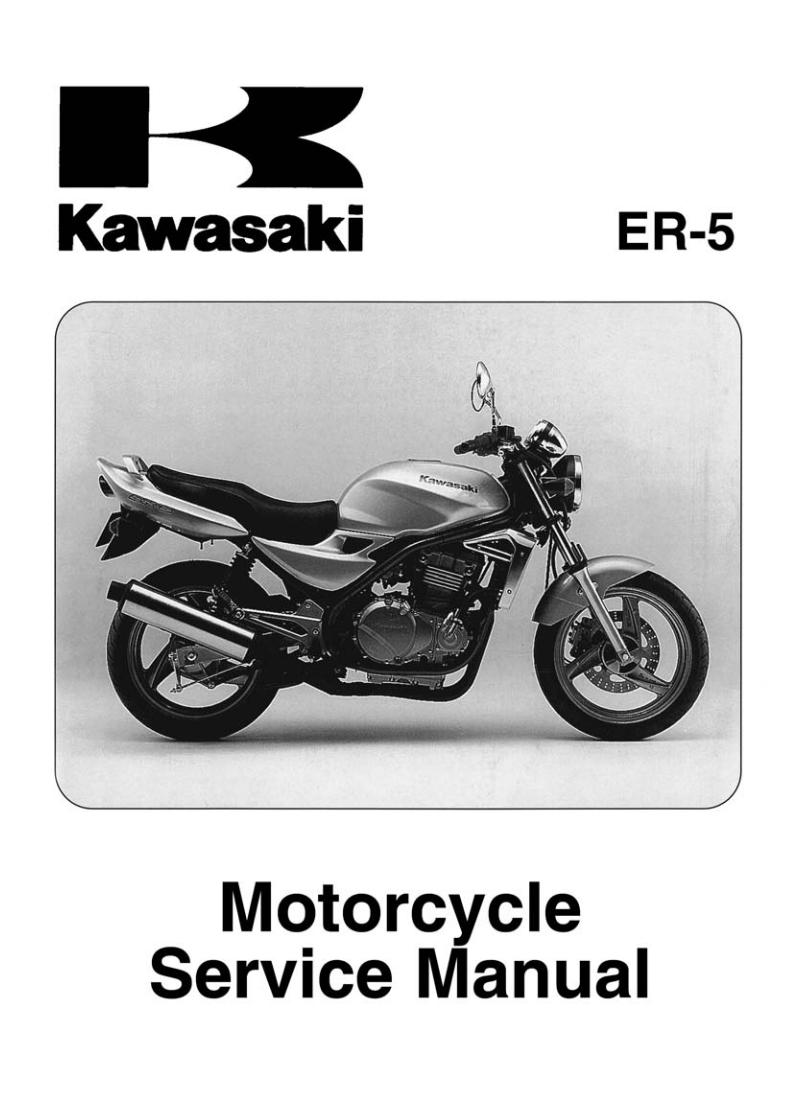
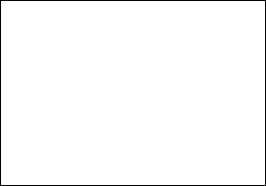
Quick Reference Guide
This quick reference guide will assist you in locating a desired topic or procedure.
•Bend the pages back to match the black tab of the desired chapter number with the black tab on the edge at each table of contents page.
•Refer to the sectional table of contents for the exact pages to locate the specific topic required.
General Information |
1 |
j |
|
|
|
Fuel System |
2 |
j |
|
|
|
Cooling System |
3 |
j |
|
|
|
Engine Top End |
4 |
j |
|
|
|
Clutch |
5 |
j |
|
|
|
Engine Lubrication System |
6 |
j |
|
|
|
Engine Removal/Installation |
7 |
j |
|
|
|
Crankshaft/Transmission |
8 |
j |
|
|
|
Wheels/Tires |
9 |
j |
|
|
|
Final Drive |
10 |
j |
|
|
|
Brakes |
11 |
j |
|
|
|
Suspension |
12 |
j |
|
|
|
Steering |
13 |
j |
|
|
|
Frame |
14 |
j |
|
|
|
Electrical System |
15 |
j |
|
|
|
Appendix |
16 |
j |
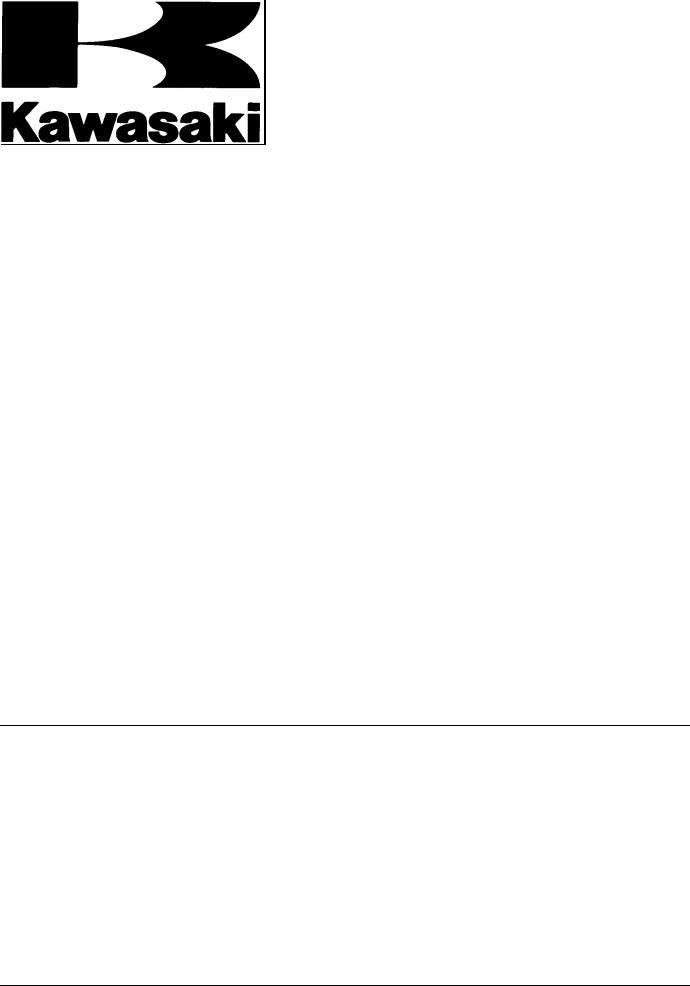
ER-5
Motorcycle
Service Manual
All rights reserved. No parts of this publication may be reproduced, stored in a retrieval system, or transmitted in any form or by any means, electronic mechanical photocopying, recording or otherwise, without the prior written permission of Quality Assurance Department/Consumer Products & Machinery Company/Kawasaki Heavy Industries, Ltd., Japan.
No liability can be accepted for any inaccuracies or omissions in this publication, although every possible care has been taken to make it as complete and accurate as possible.
The right is reserved to make changes at any time without prior notice and without incurring an obligation to make such changes to products manufactured previously. See your Motorcycle dealer for the latest information on product improvements incorporated after this publication.
All information contained in this publication is based on the latest product information available at the time of publication. Illustrations and photographs in this publication are intended for reference use only and may not depict actual model component parts.
© 2000 Kawasaki Heavy Industries, Ltd. |
4th Edition (1): Aug. 5, 2004 (K) |
LIST OF ABBREVIATIONS
A |
ampere(s) |
lb |
pound(s) |
ABDC |
after bottom dead center |
m |
meter(s) |
AC |
alternating current |
min |
minute(s) |
ATDC |
after top dead center |
N |
newton(s) |
BBDC |
before bottom dead center |
Pa |
pascal(s) |
BDC |
bottom dead center |
PS |
horsepower |
BTDC |
before top dead center |
psi |
pound(s) per square inch |
°C |
degree(s) Celsius |
r |
revolution |
DC |
direct current |
rpm |
revolution(s) per minute |
F |
farad(s) |
TDC |
top dead center |
°F |
degree(s) Fahrenheit |
TIR |
total indicator reading |
ft |
foot, feet |
V |
volt(s) |
g |
gram(s) |
W |
watt(s) |
h |
hour(s) |
Ω |
ohm(s) |
L |
liter(s) |
|
|
Read OWNER’S MANUAL before operating.

EMISSION CONTROL INFORMATION
To protect the environment in which we all live, Kawasaki has incorporated crankcase emission (1) and exhaust emission (2) control systems in compliance with applicable regulations of the United States Environmental Protection Agency and California Air Resources Board. Additionally, Kawasaki has incorporated an evaporative emission control system (3) in compliance with applicable regulations of the California Air Resources Board on vehicles sold in California only.
1. Crankcase Emission Control System
This system eliminates the release of crankcase vapors into the atmosphere. Instead, the vapors are routed through an oil separator to the intake side of the engine. While the engine is operating, the vapors are drawn into combustion chamber, where they are burned along with the fuel and air supplied by the carburetion system.
2. Exhaust Emission Control System
This system reduces the amount of pollutants discharged into the atmosphere by the exhaust of this motorcycle. The fuel, ignition, and exhaust systems of this motorcycle have been carefully designed and constructed to ensure an efficient engine with low exhaust pollutant levels.
3. Evaporative Emission Control System
Vapors caused by fuel evaporation in the fuel system are not vented into the atmosphere. Instead, fuel vapors are routed into the running engine to be burned, or stored in a canister when the engine is stopped. Liquid fuel is caught by a vapor separator and returned to the fuel tank.
The Clean Air Act, which is the Federal law covering motor vehicle pollution, contains what is commonly referred to as the Act’s "tampering provisions."
"Sec. 203(a) The following acts and the causing thereof are prohibited...
(3)(A) for any person to remove or render inoperative any device or element of design installed on or in a motor vehicle or motor vehicle engine in compliance with regulations under this title prior to its sale and delivery to the ultimate purchaser, or for any manufacturer or dealer knowingly to remove or render inoperative any such device or element of design after such sale and delivery to the ultimate purchaser.
(3)(B) for any person engaged in the business of repairing, servicing, selling, leasing, or trading motor vehicles or motor vehicle engines, or who operates a fleet of motor vehicles knowingly to remove or render inoperative any device or element of design installed on or in a motor vehicle or motor vehicle engine in compliance with regulations under this title following its sale and delivery to the ultimate purchaser..."
NOTE
○The phrase "remove or render inoperative any device or element of design" has been generally interpreted as follows:
1.Tampering does not include the temporary removal or rendering inoperative of devices or elements of design in order to perform maintenance.
2.Tampering could include:
a.Maladjustment of vehicle components such that the emission standards are exceeded.
b.Use of replacement parts or accessories which adversely affect the performance or durability of the motorcycle.
c.Addition of components or accessories that result in the vehicle exceeding the standards.
d.Permanently removing, disconnecting, or rendering inoperative any component or element of design of the emission control systems.
WE RECOMMEND THAT ALL DEALERS OBSERVE THESE PROVISIONS OF FEDERAL LAW, THE VIOLATION OF WHICH IS PUNISHABLE BY CIVIL PENALTIES NOT EXCEEDING $10,000 PER VIOLATION.

TAMPERING WITH NOISE CONTROL SYSTEM PROHIBITED
Federal law prohibits the following acts or the causing thereof: (1) The removal or rendering inoperative by any person other than for purposes of maintenance, repair, or replacement, of any device or element of design incorporated into any new vehicle for the purpose of noise control prior to its sale or delivery to the ultimate purchaser or while it is in use, or (2) the use of the vehicle after such device or element of design has been removed or rendered inoperative by any person.
Among those acts presumed to constitute tampering are the acts listed below:
•Replacement of the original exhaust system or muffler with a component not in compliance with Federal regulations.
•Removal of the muffler(s) or any internal portion of the muffler(s).
•Removal of the air box or air box cover.
•Modifications to the muffler(s) or air intake system by cutting, drilling, or other means if such modifications result in increased noise levels.
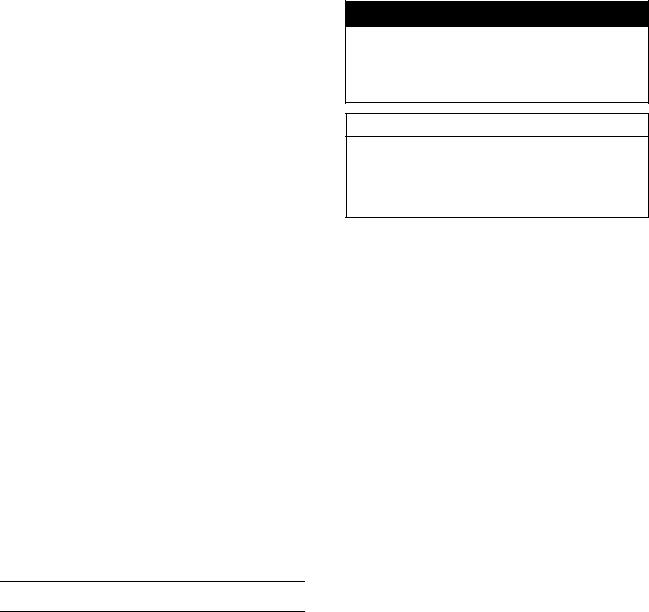
Foreword
This manual is designed primarily for use by trained mechanics in a properly equipped shop. However, it contains enough detail and basic information to make it useful to the owner who desires to perform his own basic maintenance and repair work. A basic knowledge of mechanics, the proper use of tools, and workshop procedures must be understood in order to carry out maintenance and repair satisfactorily. Whenever the owner has insufficient experience or doubts his ability to do the work, all adjustments, maintenance, and repair should be carried out only by qualified mechanics.
In order to perform the work efficiently and to avoid costly mistakes, read the text, thoroughly familiarize yourself with the procedures before starting work, and then do the work carefully in a clean area. Whenever special tools or equipment are specified, do not use makeshift tools or equipment. Precision measurements can only be made if the proper instruments are used, and the use of substitute tools may adversely affect safe operation.
For the duration of the warranty period, we recommend that all repairs and scheduled maintenance be performed in accordance with this service manual. Any owner maintenance or repair procedure not performed in accordance with this manual may void the warranty.
To get the longest life out of your vehicle:
•Follow the Periodic Maintenance Chart in the Service Manual.
•Be alert for problems and non-scheduled maintenance.
•Use proper tools and genuine Kawasaki Motorcycle parts. Special tools, gauges, and testers that are necessary when servicing Kawasaki motorcycles are introduced by the Special Tool Catalog or Manual. Genuine parts provided as spare parts are listed in the Parts Catalog.
•Follow the procedures in this manual carefully. Don’t take shortcuts.
•Remember to keep complete records of maintenance and repair with dates and any new parts installed.
How to Use This Manual
In this manual, the product is divided into its major systems and these systems make up the manual’s chapters.
The Quick Reference Guide shows you all of the product’s system and assists in locating their chapters. Each chapter in turn has its own comprehensive Table of Contents.
For example, if you want ignition coil information, use the Quick Reference Guide to locate the Electrical System chapter. Then, use the Table of Contents on the first page of the chapter to find the ignition coil section.
Whenever you see these WARNING and CAUTION symbols, heed their instructions! Always follow safe operating and maintenance practices.

 WARNING
WARNING
This warning symbol identifies special instructions or procedures which, if not correctly followed, could result in personal injury, or loss of life.
CAUTION
This caution symbol identifies special instructions or procedures which, if not strictly observed, could result in damage to or destruction of equipment.
This manual contains four more symbols (in addition to WARNING and CAUTION) which will help you distinguish different types of information.
NOTE
○This note symbol indicates points of particular interest for more efficient and convenient operation.
•Indicatesdone. a procedural step or work to be ○Indicates a procedural sub-step or how to do the work of the procedural step it follows. It
also precedes the text of a NOTE.
 Indicates a conditional step or what action to take based on the results of the test or inspection in the procedural step or sub-step it follows.
Indicates a conditional step or what action to take based on the results of the test or inspection in the procedural step or sub-step it follows.
In most chapters an exploded view illustration of the system components follows the Table of Contents. In these illustrations you will find the instructions indicating which parts require specified tightening torque, oil, grease or a locking agent during assembly.

GENERAL INFORMATION 1-1
General Information |
|
|
|
|
1 |
|
|
Table of Contents |
|
|
|
Before Servicing ..................................................................................................................... |
1-2 |
|
|
Model Identification................................................................................................................. |
1-5 |
|
|
General Specifications............................................................................................................ |
1-6 |
|
|
Periodic Maintenance Chart ................................................................................................... |
1-9 |
|
|
Torque and Locking Agent...................................................................................................... |
1-11 |
|
|
Special Tools and Sealants .................................................................................................... |
1-16 |
|
|
Cable, Wire, and Hose Routing.............................................................................................. |
1-23 |
|
|

1-2 GENERAL INFORMATION
Before Servicing
Before starting to perform an inspection service or carry out a disassembly and reassembly operation on a motorcycle, read the precautions given below. To facilitate actual operations, notes, illustrations, photographs, cautions, and detailed descriptions have been included in each chapter wherever necessary. This section explains the items that require particular attention during the removal and reinstallation or disassembly and reassembly of general parts.
Especially note the following:
(1) Dirt
Before removal and disassembly, clean the motorcycle. Any dirt entering the engine will shorten the life of the motorcycle. For the same reason, before installing a new part, clean off any dust or metal filings.
(2) Battery Ground
Disconnect the ground (–) wire from the battery before performing any disassembly operations on the motorcycle. This prevents the engine from accidentally turning over while work is being carried out, sparks from being generated while disconnecting the wires from electrical parts, as well as damage to the electrical parts themselves. For reinstallation, first connect the positive wire to the positive (+) terminal of the battery
(3) Installation, Assembly
Generally, installation or assembly is the reverse of removal or disassembly. However, if installation or assembly sequence is given in this Service Manual, follow it. Note parts locations and cable, wire, and hose routing during removal or disassembly so they can be installed or assembled in the same way. It is preferable to mark and record the locations and routing whenever possible.
(4) Tightening Sequence
When installing bolts, nuts, or screws for which a tightening sequence is given in this Service Manual, make sure to follow the sequence. When installing a part with several bolts, nuts, or screws, start them all in their holes and tighten them to a snug fit, thus ensuring that the part has been installed in its proper location. Then, tighten them to the specified torque in the tightening sequence and method indicated. If tightening sequence instructions are not given, tighten them evenly in a cross pattern. Conversely, to remove a part, first loosen all the bolts, nuts, or screws that are retaining the part a 1/4-turn before removing them.
(5) Torque
When torque values are given in this Service Manual, use them. Either too little or too much torque may lead to serious damage. Use a good quality, reliable torque wrench.
(6) Force
Common sense should dictate how much force is necessary in assembly and disassembly. If a part seems especially difficult to remove or install, stop and examine what may be causing the problem. Whenever tapping is necessary, tap lightly using a wooden or plastic-faced mallet. Use an impact driver for screws (particularly for the removing screws held by non-permanent locking agent) in order to avoid damaging the screw heads.
(7) Edges
Watch for sharp edges, as they could cause injury through careless handling, especially during major engine disassembly and assembly. Use a clean piece of thick cloth when lifting the engine or turning it over.
(8) High-Flash Point Solvent
A high-flash point solvent is recommended to reduce fire danger. A commercial solvent commonly available in North America is standard solvent (generic name). Always follow manufacturer and container directions regarding the use of any solvent.
(9) Gasket, O-ring
Replace a gasket or an O-ring with a new part when disassembling. Remove any foreign matter from the mating surface of the gasket or O-ring to ensure a perfectly smooth surface to prevent oil or compression leaks.

GENERAL INFORMATION 1-3
Before Servicing
(10)Liquid Gasket, Locking Agent
Clean and prepare surfaces where liquid gasket or non-permanent locking agent will be used. Apply them sparingly. Excessive amount may block engine oil passages and cause serious damage.
(11)Press
When using a press or driver to install a part such as a wheel bearing, apply a small amount of oil to the area where the two parts come in contact to ensure a smooth fit.
(12)Ball Bearing and Needle Bearing
Do not remove a ball bearing or a needle bearing unless it is absolutely necessary. Replace any ball or needle bearings that were removed with new ones. Install bearings with the manufacturer and size marks facing out, applying pressure evenly with a suitable driver. Apply force only to the end of the race that contacts the press fit portion, and press it evenly over the base component.
(13)Oil Seal and Grease Seal
Replace any oil or grease seals that were removed with new ones, as removal generally damages seals. Oil or grease seals should be pressed into place using a suitable driver, applying a force uniformly to the end of seal until the face of the seal is even with the end of the hole, unless instructed otherwise. When pressing in an oil or grease seal which has manufacturer’s marks, press it in with the marks facing out.
(14)Circlip, Retaining Ring, and Cotter Pin
When installing circlips and retaining rings, take care to compress or expand them only enough to install them and no more. Install the circlip with its chamfered side facing load side as well.
Replace any circlips, retaining rings, and cotter pins that were removed with new ones, as removal weakens and deforms them. If old ones are reused, they could become detached while the motorcycle is driven, leading to a major problem.
(15)Lubrication
Engine wear is generally at its maximum while the engine is warming up and before all the sliding surfaces have an adequate lubricative film. During assembly, make sure to apply oil to any sliding surface or bearing that has been cleaned. Old grease or dirty oil could have lost its lubricative quality and may contain foreign particles that act as abrasives; therefore, make sure to wipe it off and apply fresh grease or oil. Some oils and greases in particular should be used only in certain applications and may be harmful if used in an application for which they are not intended.
(16)Direction of Engine Rotation
To rotate the crankshaft manually, make sure to do so in the direction of positive rotation. Positive rotation is counterclockwise as viewed from the left side of the engine. To carry out proper adjustment, it is furthermore necessary to rotate the engine in the direction of positive rotation as well.
(17)Replacement Parts
When there is a replacement instruction, replace these parts with new ones every time they are removed.
Replacement parts will be damaged or lose their original function once they are removed. Therefore, always replace these parts with new ones every time they are removed. Although the previously mentioned gasket, O-ring, ball bearing, needle bearing, grease seal, oil seal, circlip, and cotter pin have not been so designated in their respective text, they are replacement parts.
(18)Electrical Wires
All the electrical wires are either one-color or two-color. A two-color wire is identified first by the primary color and then the stripe color. For example, a yellow wire with thin red stripes is referred to as a “yellow/red” wire; it would be a “red/yellow” wire if the colors were reversed. Unless instructed otherwise, electrical wires must be connected to wires of the same color.
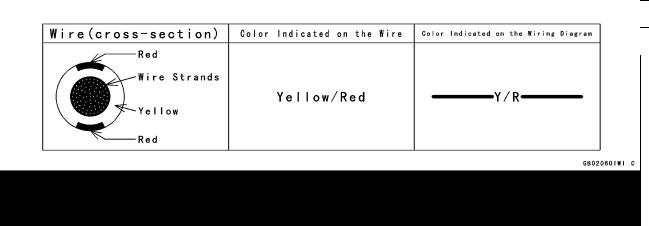
1-4 GENERAL INFORMATION
Before Servicing
Two-Color Electrical
(19)Inspection
When parts have been disassembled, visually inspect these parts for the following conditions or other damage. If there is any doubt as to the condition of them, replace them with new ones.
Abrasion |
Crack |
Hardening |
Warp |
Bent |
Dent |
Scratch |
Wear |
Color change |
Deterioration |
Seizure |
|
(20)Specifications
Specification terms are defined as follows:
"Standards" show dimensions or performances which brand-new parts or systems have. "Service Limits" indicate the usable limits. If the measurement shows excessive wear or dete-
riorated performance, replace the damaged parts.
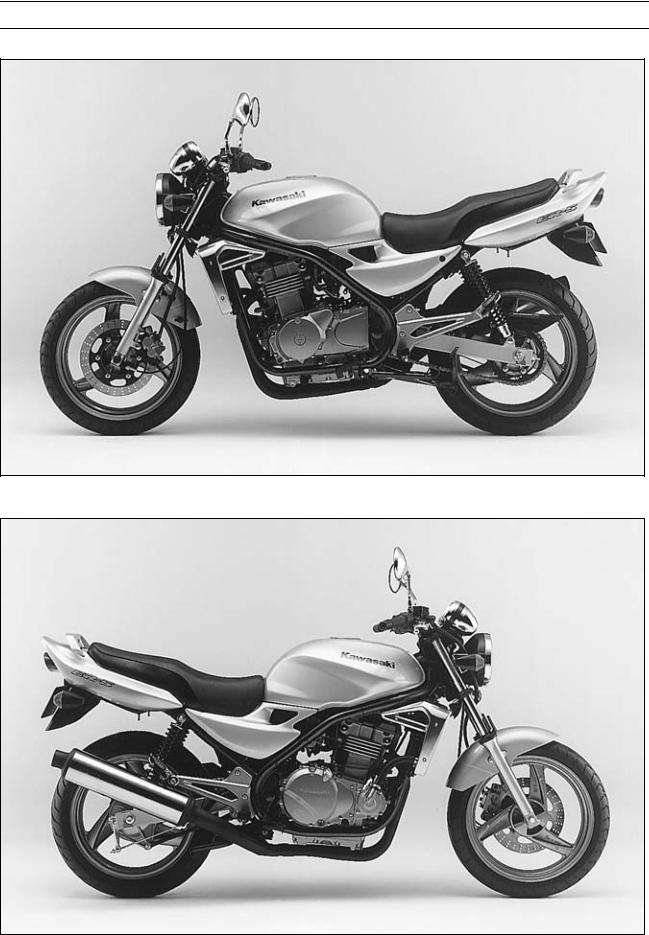
GENERAL INFORMATION 1-5
Model Identification
ER500-C1, D1 Left Side View
ER500-C1, D1 Right Side View

1-6 GENERAL INFORMATION
General Specifications
Items |
EN500-C1 C2 |
EN500-C3 |
EN500-D1 |
Dimensions |
|
|
|
Overall Length |
2 070 mm (81.5 in.) |
← |
← |
Overall Width |
730 mm (28.74 in.) |
← |
← |
Overall Height |
1 070 mm (42.13 in.) |
← |
← |
Wheelbase |
1 430 mm (56.3 in.) |
← |
← |
Road Clearance |
125 mm (4.92 in.) |
← |
← |
Seat Height |
800 mm (31.5 in.) |
← |
← |
Dry Weight |
179 kg (395 lb.) |
← |
← |
Curb Weight: |
|
|
|
Front |
92 kg (203 lb.) |
← |
← |
Rear |
107 kg (236 lb.) |
← |
← |
Fuel tank Capacity |
17 L (4.5 US gal.) |
← |
← |
Performance |
|
|
|
Minimum Turning Radius |
2.5 m (8.2 ft.) |
← |
← |
Engine |
|
|
|
Type |
4-stroke, DOHC, 2-cylinder |
← |
← |
Cooling System |
Liquid-cooled |
← |
← |
Bore and Stroke |
74.0 × 58.0 mm (2.91 × 2.28 in.) |
← |
← |
Displacement |
498 mL (30.39 cu in.) |
← |
← |
Compression Ratio |
9.8:1 |
← |
← |
Maximum Horsepower |
37 kW (50.3 PS) @9 000 r/min (rpm) |
← |
25 kW (34 |
|
|
|
PS) @8 000 |
|
|
|
r/min (rpm) |
Maximum Torque |
45 N·m (4.6 kgf·m, 33 ft·lb) @7 200 |
← |
37 N·m (3.8 |
|
r/min (rpm) |
|
kgf·m, 27 |
|
|
|
ft·lb) @4 500 |
|
|
|
r/min (rpm) |
Carburetion System |
Carburetors, Keihin CVK34 × 2 |
← |
← |
Starting System |
Electric starter |
← |
← |
Ignition System |
Battery and coil (transistorized) |
← |
← |
Timing Advance |
Electronically Advanced (digital) |
← |
← |
Ignition Timing |
From 10° BTDC @1 200 r/min (rpm) |
← |
← |
|
to 37.5° BTDC @10 000 r/min (rpm) |
|
|
Spark Plugs |
NGK DR9EA or ND X27ESR-U |
← |
← |
Cylinder Numbering Method |
Left to right, 1-2 |
← |
← |
Firing Order |
1-2 |
← |
← |
Valve Timing: |
|
|
|
Inlet |
|
|
|
Open |
31° BTDC |
← |
← |
Close |
51° ABDC |
← |
← |
DuRation |
262° |
← |
← |
Exhaust |
|
|
|
Open |
56° BBDC |
← |
← |
Close |
26° ATDC |
← |
← |
DuRation |
262° |
← |
← |

GENERAL INFORMATION 1-7
General Specifications
Items |
EN500-C1 C2 |
EN500-C3 |
EN500-D1 |
Lubrication System |
Forced lubrication |
← |
← |
Engine Oil: |
|
|
|
Grade |
API SE, SF, SG or |
← |
← |
|
API SH or SJ with JASO MA |
|
|
Viscosity |
SAE10W-40 |
← |
← |
Capacity |
3.4 L (3.6 us at) |
← |
← |
Drive Train |
|
|
|
Primary Reduction System: |
|
|
|
Type |
Chain |
← |
← |
Reduction Ratio |
2.652 (61/23) |
← |
← |
Clutch Type |
Wet multi disc |
← |
← |
Transmission: |
|
|
|
Type |
6-speed constant mesh, return shift |
← |
← |
Gear Ratios: |
|
|
|
1st |
2.571 (36/14) |
← |
← |
2nd |
1.722 (31/18) |
← |
← |
3rd |
1.333 (28/21) |
← |
← |
4th |
1.125 (27/24) |
← |
← |
5th |
0.961 (25/26) |
← |
← |
6th |
0.851 (23/27) |
← |
← |
Final Drive System: |
|
|
|
Type |
Chain drive |
← |
← |
Reduction Ratio |
2.470 (42/17) |
← |
← |
Overall Drive Ratio |
5.581 @Top gear |
← |
← |
Frame |
|
|
|
Type |
Tubular, double cradle |
← |
← |
Caster (rake angle) |
27° |
← |
← |
Trail |
102 mm (4.02 in.) |
← |
← |
Front Tire: |
|
|
|
Type |
Tubeless |
← |
← |
Size |
110/70-17 54H |
110/70-17 |
110/70-17 |
|
|
M/C 54H |
54H |
Rear Tire: |
|
|
|
Type |
Tubeless |
← |
← |
Size |
130/70-17 62H |
130/70-17 |
130/70-17 |
|
|
M/C 62H |
62H |
Front Suspension: |
|
|
|
Type |
Telescopic fork |
← |
← |
Wheel Travel |
125 mm (4.92 in.) |
← |
← |
Rear Suspension: |
|
|
|
Type |
Swingarm |
← |
← |
Wheel Travel |
114 mm (4.49 in.) |
← |
← |
Brake Type: |
|
|
|
Front |
Single disc |
← |
← |
Rear |
Drum |
← |
← |

1-8 GENERAL INFORMATION
General Specifications
Items |
EN500-C1 C2 |
EN500-C3 |
EN500-D1 |
Electrical Equipment |
|
|
|
Battery |
12 V 10 Ah |
← |
← |
Headlight: |
|
|
|
Type |
Semi-sealed beam |
← |
← |
Bulb |
12 V 60/55 W (quartz-halogen) |
← |
← |
Tail/brake Light |
12 V 5/21 W × 2 |
← |
← |
Alternator: |
|
|
|
Type |
Three-phase AC |
← |
← |
Rated output |
17 A × 14 V @6 000 r/min (rpm) |
← |
← |
Specifications subject to change without notice, and may not apply to every country.

GENERAL INFORMATION 1-9
Periodic Maintenance Chart
The scheduled maintenance must be done in accordance with this chart to keep the motorcycle in good running condition. The initial maintenance is vitally important and must not be neglected.
FREQUENCY |
Whichever |
|
|
|
* ODOMETER READING |
||||||||
|
comes |
|
|
|
|
|
|
|
|
× 1 000 km |
|||
|
|
|
|
|
|
|
|
|
|||||
|
first |
|
|
|
|
|
|
|
(× 1 000 mile) |
||||
|
|
|
|
|
|
|
|
||||||
|
|
|
|
|
1 |
6 |
12 |
18 |
24 |
30 |
36 |
Remarks |
|
|
|
|
|
|
|||||||||
|
|
|
|
|
|
|
|
|
|
|
|
|
|
INSPECTION |
Every |
|
(0.6) |
(4) |
(7.5) |
(12) |
(15) |
(20) |
(24) |
||||
|
|
||||||||||||
Throttle cable - inspect † |
|
|
|
|
• |
|
• |
|
• |
|
• |
|
|
|
|
|
|
|
|
|
|
|
|
|
|
|
|
|
|
|
|
|
|
|
|
|
|
|
|
|
|
Idle speed - inspect † |
|
|
|
|
• |
|
• |
|
• |
|
• |
|
|
|
|
|
|
|
|
|
|
|
|
|
|
|
|
|
|
|
|
|
|
|
|
|
|
|
|
|
|
Carburetor synchronization - |
|
|
|
|
|
|
|
• |
|
• |
|
• |
|
inspect † |
|
|
|
|
|
|
|
|
|
|
|||
Air cleaner element - clean† # |
|
|
|
|
|
|
|
• |
|
• |
|
• |
|
|
|
|
|
|
|
|
|
|
|
|
|
|
|
Fuel hoses, connections - inspect |
|
|
|
|
|
|
• |
• |
• |
• |
• |
• |
|
† |
|
|
|
|
|
|
|
||||||
Coolant filter - clean |
years |
|
|
|
|
|
|
|
|
|
|
||
Radiator hoses, connections - |
|
|
|
|
• |
|
|
|
|
|
|
|
|
inspect † |
|
|
|
|
|
|
|
|
|
|
|
||
Air suction valve - inspect † |
|
|
|
|
|
|
• |
• |
• |
• |
• |
• |
|
|
|
|
|
|
|
|
|
|
|
|
|
|
|
|
|
|
|
|
|
|
|
|
|
|
|
|
|
|
|
|
|
|
|
|
|
• |
|
• |
|
• |
before 2005 |
Valve clearance - inspect † |
|
|
|
|
|
|
|
|
|
model |
|||
|
|
|
|
|
|
|
|
|
• |
|
|
after 2005 |
|
|
|
|
|
|
|
|
|
|
|
|
|
||
|
|
|
|
|
|
|
|
|
|
|
|
model |
|
Clutch adjust - inspect † |
|
|
|
|
• |
• |
• |
• |
• |
• |
• |
|
|
|
|
|
|
|
|
|
|
|
|
|
|
|
|
|
|
|
|
|
|
|
|
|
|
|
|
|
|
Tire wear - inspect † |
|
|
|
|
|
|
• |
• |
• |
• |
• |
• |
|
|
|
|
|
|
|
|
|
|
|
|
|
|
|
|
|
|
|
|
|
|
|
|
|
|
|
|
|
Drive chain wear - inspect †# |
|
|
|
|
|
|
• |
• |
• |
• |
• |
• |
|
|
|
|
|
|
|
|
|
|
|
|
|
|
|
|
|
|
|
|
|
|
|
|
|
|
|
||
Drive chain - lubricate # |
600 km |
|
|
|
|
|
|
|
|
|
|
||
Drive chain slack - inspect †# |
1000 km |
|
|
|
|
|
|
|
|
|
|
||
Brake Play - inspect †# |
|
|
|
|
• |
• |
• |
• |
• |
• |
• |
|
|
|
|
|
|
|
|
|
|
|
|
|
|
|
|
|
|
|
|
|
|
|
|
|
|
|
|||
Brake fluid level - inspect † |
month |
|
• |
• |
• |
• |
• |
• |
• |
|
|||
Brake hoses, connections - |
|
|
|
|
|
|
• |
• |
• |
• |
• |
• |
|
inspect † |
|
|
|
|
|
|
|
||||||
Brake lining or pad wear - inspect |
|
|
|
|
|
|
• |
• |
• |
• |
• |
• |
|
†# |
|
|
|
|
|
|
|
||||||
Brake light switch - inspect † |
|
|
|
|
• |
• |
• |
• |
• |
• |
• |
|
|
|
|
|
|
|
|
|
|
|
|
|
|
|
|
|
|
|
|
|
|
|
|
|
|
|
|
|
|
Front fork oil leak - inspect † |
|
|
|
|
|
|
|
• |
|
• |
|
• |
|
|
|
|
|
|
|
|
|
|
|
|
|
|
|
|
|
|
|
|
|
|
|
|
|
|
|
|
|
Rear shock absorber oil leak - |
|
|
|
|
|
|
|
• |
|
• |
|
• |
|
inspect † |
|
|
|
|
|
|
|
|
|
|
|||
Swingarm pivot - lubricate |
|
|
|
|
|
|
|
• |
|
• |
|
• |
|
|
|
|
|
|
|
|
|
|
|
|
|
|
|
|
|
|
|
|
|
|
|
|
|
|
|
|
|
Steering - inspect † |
|
|
|
|
• |
• |
• |
• |
• |
• |
• |
|
|
|
|
|
|
|
|
|
|
|
|
|
|
|
|
|
|
|
|
|
|
|
|
|
|
|
|
|
|
Steering stem bearing - lubricate |
2 years |
|
|
|
|
|
|
• |
|
|
|
||
|
|
|
|
|
|
|
|
|
|
||||
|
|
|
|
|
|
|
|
|
|
|
|
|
|
Spark plug - clean and gap † |
|
|
|
|
|
|
• |
• |
• |
• |
• |
• |
|
|
|
|
|
|
|
|
|
|
|
|
|
|
|
|
|
|
|
|
|
|
|
|
|
|
|
|
|
General lubrication - perform |
|
|
|
|
|
|
|
• |
|
• |
|
• |
|
|
|
|
|
|
|
|
|
|
|
|
|
|
|
|
|
|
|
|
|
|
|
|
|
|
|
|
|
Nut, bolts, and fasteners tightness |
|
|
|
|
• |
|
• |
|
• |
|
• |
|
|
- inspect † |
|
|
|
|
|
|
|
|
|||||
Coolant - change |
2 years |
|
|
|
|
|
|
• |
|
|
|
||
|
|
|
|
|
|
|
|
|
|
||||
|
|
|
|
|
|
|
|
|
|
|
|
|
|

1-10 GENERAL INFORMATION
Periodic Maintenance Chart
FREQUENCY |
Whichever |
|
|
|
|
|
* ODOMETER READING |
||||||||
|
comes |
|
|
|
|
|
|
|
|
|
× 1 000 km |
||||
|
|
|
|
|
|
|
|
|
|
||||||
|
first |
|
|
|
|
|
|
|
|
(× 1 000 mile) |
|||||
|
|
|
|
|
|
|
|
|
|||||||
|
|
|
|
|
|
1 |
6 |
12 |
18 |
24 |
30 |
36 |
Remarks |
||
|
|
|
|
|
|
||||||||||
INSPECTION |
Every |
(0.6) |
(4) |
(7.5) |
(12) |
(15) |
(20) |
(24) |
|||||||
|
|||||||||||||||
Engine oil - change # |
year |
|
|
• |
• |
• |
• |
• |
• |
• |
|
||||
|
|
|
|
|
|
|
|
|
|
||||||
|
|
|
|
|
|
|
|
|
|
|
|
|
|
||
Oil filter - replace |
|
|
|
|
|
• |
|
• |
|
• |
|
• |
|
||
|
|
|
|
|
|
|
|
|
|
|
|
|
|
||
|
|
|
|
|
|
|
|
|
|
|
|
|
|
|
|
Brake fluid - change |
2 years |
|
|
|
|
|
|
|
• |
|
|
|
|||
|
|
|
|
|
|
|
|
|
|
||||||
|
|
|
|
|
|
|
|
|
|
|
|
|
|
|
|
Brake master cylinder cup and |
4 years |
|
|
|
|
|
|
|
|
|
|
|
|||
dust seal - replace |
|
|
|
|
|
|
|
|
|
|
|||||
|
|
|
|
|
|
|
|
|
|
|
|
|
|
||
Caliper piston seal and dust seal |
4 years |
|
|
|
|
|
|
|
|
|
|
|
|||
- replace |
|
|
|
|
|
|
|
|
|
|
|||||
|
|
|
|
|
|
|
|
|
|
|
|
|
|
||
Front Fork oil - change |
2 years |
|
|
|
|
|
|
|
• |
|
|
|
|||
|
|
|
|
|
|
|
|
|
|
||||||
#: Service more frequently when operating in severe conditions; dusty, wet, muddy, high speed, or frequent starting/stopping.
*: For higher odometer readings, repeat at the frequency interval established here. †: Replace, add, adjust, clean, or torque if necessary.

GENERAL INFORMATION 1-11
Torque and Locking Agent
Tighten all bolts and nuts to the proper torque using an accurate torque wrench. An insufficiently tightened bolt or nut may become damaged or fall off, possibly resulting in damage to the motorcycle and injury to the rider. A bolt or nut which is overtightened may become damaged, strip an internal thread, or break and then fall out. The following table lists the tightening torque for the major bolts and nuts, and the parts requiring use of a non-permanent locking agent or liquid gasket.
When checking the tightening torque of the bolts and nuts, first loosen the bolt or nut by half a turn and then tighten it to the specified torque.
Letters used in the "Remarks" column mean:
L:Apply a non-permanent locking agent to the threads. LG: Apply liquid gasket to the threads.
Lh: Left-hand threads.
M:Apply molybdenum disulfide grease.
O:Apply an oil to the threads and seating surface.
R:Replacement parts.
S:Tighten the fasteners following the specified sequence.
SS:Apply silicone sealant to the threads.
St: Stake the fasteners to prevent loosening.
The table relating tightening torque to thread diameter, lists the basic torque for the bolts and nuts. Use this table for only the bolts and nuts which do not require a specific torque value. All of the values are for use with dry solvent-cleaned threads.
Basic Torque for General Fasteners
Threads |
|
|
|
|
|
Torque |
|
|
|
|
|||
dia. (mm) |
|
N·m |
|
kgf·m |
|
|
ft·lb |
||||||
5 |
|
3.4 |
|
4.9 |
|
0.35 |
0.50 |
|
30 |
43 in·lb |
|||
6 |
|
5.9 |
|
7.8 |
|
0.60 |
0.80 |
|
52 |
69 in·lb |
|||
8 |
|
14 19 |
|
1.4 1.9 |
|
10.0 |
13.5 |
||||||
10 |
|
25 |
|
34 |
|
2.6 |
3.5 |
|
19.0 |
25 |
|||
12 |
|
44 |
|
61 |
|
4.5 |
6.2 |
|
33 |
45 |
|||
14 |
|
73 |
|
98 |
|
7.4 |
10.0 |
|
54 |
72 |
|||
16 |
|
115 |
155 |
|
11.5 |
16.0 |
|
83 |
115 |
||||
18 |
|
165 |
|
225 |
|
17.0 |
23.0 |
|
125 |
165 |
|||
20 |
|
225 |
|
325 |
|
23 |
33 |
|
165 |
240 |
|||
|
|
|
|
|
|
|
|
|
|
|
|
|
|
Fastener |
|
|
|
|
|
Torque |
|
|
|
Remarks |
|||
|
|
|
N·m |
|
kgf·m |
ft·lb |
|
||||||
|
|
|
|
|
|
|
|
|
|||||
Fuel System |
|
|
|
|
|
|
|
|
|
|
|
|
|
Fuel Tap Plate Screws |
|
|
|
|
0.8 |
|
0.08 |
|
7 in·lb |
|
|
||
Fuel Tap Diaphragm Chamber Screws |
|
1.0 |
|
0.10 |
|
9 in·lb |
|
|
|||||
Fuel Tap Mounting Bolts |
|
|
|
|
2.5 |
|
0.25 |
|
22 in·lb |
|
|
||
Fuel Level Sensor Bolts |
|
|
|
|
6.9 |
|
0.7 |
|
61 in·lb |
|
|
||
Cooling System |
|
|
|
|
|
|
|
|
|
|
|
|
|
Radiator Hose Clamp Screws |
|
|
|
2.5 |
|
0.25 |
|
22 in·lb |
|
|
|||
Fan Switch |
|
|
|
|
18 |
|
1.8 |
|
13 |
|
|
|
|
Thermostat Housing Bolts |
|
|
|
|
11 |
|
1.1 |
|
95 in·lb |
|
|
||
Water Temperature Sensor |
|
|
|
7.8 |
|
0.8 |
|
69 in·lb |
|
SS |
|||
Water Pump Cover Bolts |
|
|
|
|
11 |
|
1.1 |
|
95 in·lb |
|
|
||
Water Pump Shaft |
|
|
|
|
25 |
|
2.5 |
|
18 |
|
|
Lh |
|
Water Pump Impeller |
|
|
|
|
9.8 |
|
1.0 |
|
87 in·lb |
|
Lh |
||

1-12 GENERAL INFORMATION
Torque and Locking Agent
Fastener |
|
Torque |
|
|
Remarks |
||
N·m |
kgf·m |
ft·lb |
|||||
|
|
|
|||||
Water Pipe Bolts |
9.8 |
1.0 |
87 |
in·lb |
L |
||
Cylinder Head Jacket Plug |
9.8 |
1.0 |
87 |
in·lb |
L |
||
Air Suction Valve Cover Bolts |
11 |
1.1 |
95 |
in·lb |
|
||
Coolant Drain Plug |
11 |
1.1 |
95 |
in·lb |
|
||
Engine Top End |
|
|
|
|
|
||
Spark Plugs |
14 |
1.4 |
10 |
|
|||
Cylinder Head Cover Bolts |
9.8 |
1.0 |
87 |
in·lb |
|
||
Camshaft Cap Bolts |
12 |
1.2 |
8.5 |
S |
|||
Rocker Shafts |
|
|
|
|
|
||
|
39 |
4.0 |
29 |
|
|||
Valve Adjuster Locknuts |
|
25 |
2.5 |
18 |
|
||
Camshaft Sprocket Bolts |
|
15 |
1.5 |
|
11 |
L |
|
Cylinder Head Bolts (10 mm) |
51 |
5.2 |
38 |
S |
|||
Cylinder Head Bolts (6 mm) |
9.8 |
1.0 |
87 |
in·lb |
S |
||
Cam Chain Tensioner Mounting Bolts |
11 |
1.1 |
95 in·lb |
|
|||
Cam Chain Tensioner Cap Bolt |
13 |
1.3 |
9.5 |
|
|||
Main Oil Pipe Upper Banjo Bolts M8 |
12 |
1.2 |
8.5 |
|
|||
Main Oil Pipe Lower Banjo Bolt M10 |
20 |
2.0 |
14.5 |
|
|||
Water Pipe Bolts |
9.8 |
1.0 |
87 |
in·lb |
L |
||
Oil Pipe Bolts (in the cylinder head) |
11 |
1.1 |
95 |
in·lb |
|
||
Oil Pipe Mounting Bolt |
11 |
1.1 |
95 |
in·lb |
|
||
Clutch |
|
|
|
|
|
||
Oil Filler Plug |
1.5 |
0.15 |
13 |
in·lb |
|
||
Clutch Hub Nut |
132 |
13.5 |
98 |
|
|||
Clutch Spring Bolts |
9.3 |
0.95 |
82 |
in·lb |
|
||
Clutch Cable Holder Bolt |
11 |
1.1 |
95 |
in·lb |
|
||
Clutch Cover Bolts |
11 |
1.1 |
95 |
in·lb |
|
||
Engine Lubrication System |
|
|
|
|
|
||
Oil Filler Plug |
1.5 |
0.15 |
13 |
in·lb |
|
||
Oil Passage Plug |
18 |
1.8 |
13 |
|
|||
Oil Filter Mounting Stud |
25 |
2.5 |
18 |
L |
|||
|
|
|
|
|
|
(Planted |
|
|
|
|
|
|
|
side) |
|
Oil Filter (Cartridge Type) |
17 |
1.75 |
12.5 |
|
|||
Oil Pipe for Balancer Shaft Banjo Bolt |
20 |
2.0 |
14.5 |
|
|||
Oil Pipe for Drive Shaft Upper Banjo Bolt M6 |
7.8 |
0.8 |
69 |
in·lb |
|
||
Oil Pipe for Drive Shaft Lower Banjo Bolt M8 |
|
12 |
1.2 |
8.5 |
|
||
Oil Pipe for Output Shaft Upper Banjo Bolt M6 |
|
7.8 |
0.8 |
69 |
in·lb |
|
|
Oil Pipe for Output Shaft Lower Banjo Bolt M8 |
|
12 |
1.2 |
8.5 |
|
||
Oil Pipe for Output Shaft Mounting Bolt |
|
11 |
1.1 |
95 |
in·lb |
L |
|
Oil Pump Pipe Mounting Bolts |
|
11 |
1.1 |
95 in·lb |
L |
||
Relief Valve |
|
15 |
1.5 |
|
11 |
L |
|
Oil Pressure Switch Terminal Bolt |
|
15 |
0.15 |
13 |
in·lb |
|
|
Oil Pressure Switch |
|
15 |
1.5 |
|
11 |
SS |
|

GENERAL INFORMATION 1-13
Torque and Locking Agent
Fastener |
|
Torque |
|
|
Remarks |
|
N·m |
kgf·m |
ft·lb |
||||
|
|
|||||
Engine Oil Drain Plug |
29 |
3.0 |
22 |
|
||
Oil Pan Mounting Bolts |
11 |
1.1 |
95 |
in·lb |
|
|
Oil Pump Mounting Bolts |
11 |
1.1 |
95 |
in·lb |
|
|
Breather Body Bolt |
5.9 |
0.6 |
52 |
in·lb |
|
|
Engine Removal/Installation |
|
|
|
|
|
|
Downtube Bolts |
44 |
4.5 |
33 |
|
||
Engine Mounting Bolts and Nuts |
44 |
4.5 |
33 |
|
||
Engine Mounting Bracket Bolts |
25 |
2.5 |
18 |
|
||
Crankshaft/Transmission |
|
|
|
|
|
|
Crankcase Bolts (8 mm) |
27 |
2.8 |
20 |
S |
||
Crankcase Bolts (6 mm) |
12 |
1.2 |
8.5 |
S |
||
Upper Primary Chain Guide Mounting Nut |
|
|
95 in·lb |
L |
||
11 |
1.1 |
|||||
Lower Primary Chain Guide Mounting Bolt |
11 |
1.1 |
95 in·lb |
L |
||
Connecting Rod Big End Nuts |
36 |
3.7 |
27 |
|
||
Return Spring Pin |
20 |
2.0 |
14.5 |
L |
||
Gear Positioning Lever Pivot Stud |
– |
– |
|
– |
L |
|
|
|
|
|
|
(planted |
|
|
|
|
|
|
side) |
|
Gear Positioning Lever Nut |
11 |
1.1 |
95 |
in·lb |
|
|
Shift Pedal Mounting Bolt |
12 |
1.2 |
8.5 |
|
||
Shift Drum Bearing Holder Bolts |
11 |
1.1 |
95 |
in·lb |
L |
|
Shift Drum Cam Pin Plate Screw |
– |
– |
|
– |
L |
|
Engine Sprocket Nut |
127 |
13 |
94 |
O |
||
External Shift Mechanism Cover Bolts |
11 |
1.1 |
95 |
in·lb |
|
|
Neutral Switch |
15 |
1.5 |
|
11 |
|
|
Wheels/Tires |
|
|
|
|
|
|
Front Axle Nut |
88 |
9.0 |
65 |
|
||
Front Axle Clamp Bolt |
20 |
2.0 |
14.5 |
|
||
Rear Axle Nut |
98 |
10 |
72 |
|
||
Final Drive |
|
|
|
|
|
|
Torque Link Nuts |
34 |
3.5 |
25 |
|
||
Engine Sprocket Nut |
127 |
13 |
94 |
O |
||
Rear Sprocket Nuts |
59 |
6.0 |
43 |
|
||
Rear Coupling Studs |
– |
– |
|
– |
L |
|
|
|
|
|
|
(planted |
|
|
|
|
|
|
side) |
|
Engine Axle Nut |
98 |
10 |
72 |
|
||
Drive Chain Guide Bolts |
11 |
1.1 |
95 |
in·lb |
|
|
Brakes |
|
|
|
|
|
|
Brake Hose Banjo Bolts |
25 |
2.5 |
18 |
|
||
Reservoir Cap Screws |
1.5 |
0.15 |
13 |
in·lb |
|
|
Brake Lever Pivot Bolt |
1.0 |
0.10 |
9 in·lb |
|
||
Brake Lever Pivot Locknut |
5.9 |
0.60 |
52 |
in·lb |
|
|
Master Cylinder Clamp Bolts |
8.8 |
0.9 |
78 |
in·lb |
S |
|

1-14 GENERAL INFORMATION
Torque and Locking Agent
Fastener |
|
Torque |
|
|
Remarks |
||
N·m |
kgf·m |
ft·lb |
|||||
|
|
|
|||||
Front Brake Light Switch Mounting Screw |
1.2 |
0.12 |
10 |
in·lb |
|
||
Caliper Mounting Bolts |
34 |
3.5 |
25 |
|
|||
Caliper Bleed Valves |
7.8 |
0.8 |
69 |
in·lb |
|
||
Brake Disc Mounting Bolts |
27 |
2.8 |
20 |
L |
|||
Brake Pedal Bolt |
8.8 |
0.9 |
78 |
in·lb |
|
||
Torque Link Nuts |
34 |
3.5 |
25 |
|
|||
Brake Cam Lever Bolt |
19 |
1.9 |
13.5 |
|
|||
Suspension |
|
|
|
|
|
||
Front Fork Upper Clamp Allen Bolts |
20 |
2.0 |
14.5 |
|
|||
Front Fork Lower Clamp Allen Bolts |
35 |
3.6 |
26 |
|
|||
Front Fork Bottom Allen Bolt |
20 |
2.0 |
14.5 |
L |
|||
Front Axle Clamp Bolt |
20 |
2.0 |
14.5 |
|
|||
Rear Shock Absorber Bolts and Nuts |
34 |
3.5 |
25 |
|
|||
Swing Arm Pivot Nut |
88 |
9.0 |
65 |
|
|||
Steering |
|
|
|
|
|
||
Handlebar Clamp Bolts |
25 |
2.5 |
18 |
S |
|||
Handlebar Weight Allen Bolts |
– |
– |
|
– |
L |
||
Handlebar Switch Housing Screws |
3.4 |
0.35 |
30 in·lb |
|
|||
Steering Stem Head Bolt |
44 |
4.5 |
33 |
|
|||
Steering Stem Nut |
Hand |
Hand |
Hand |
|
|||
|
|
-Tighten |
-Tighten |
-Tighten |
|
||
|
|
(about 4.9) |
(about 0.5) |
(about 43 |
|
||
|
|
|
|
in·lb) |
|
||
Frame |
|
|
|
|
|
||
Tail Grip Bolts |
25 |
2.5 |
18 |
|
|||
Footpeg Bracket Bolts |
34 |
3.5 |
25 |
|
|||
Sidestand Bolt and Nut |
|
|
|
|
|||
44 |
4.5 |
33 |
|
||||
Center Stand Bolt and Nut |
44 |
4.5 |
33 |
|
|||
Electrical System |
|
|
|
|
|
||
Pickup Coil Mounting Allen Bolts |
8.3 |
0.85 |
74 |
in·lb |
L |
||
Timing Inspection Plug |
2.5 |
0.25 |
22 |
in·lb |
|
||
Alternator Rotor Bolt Plug |
1.5 |
0.15 |
13 |
in·lb |
|
||
Alternator Cover Bolts |
|
|
|
|
in·lb |
|
|
|
11 |
1.1 |
95 |
|
|||
Alternator Cover Allen Bolt |
|
13 |
1.3 |
9.5 |
|
||
Alternator Lead Clamp Screws |
|
2.9 |
0.30 |
26 |
in·lb |
|
|
Spark Plug |
|
14 |
1.4 |
10 |
|
||
Alternator Stator Allen Bolts |
|
12 |
1.2 |
8.5 |
|
||
Alternator Rotor Bolt |
|
69 |
7.0 |
51 |
|
||
Starter Motor Mounting Bolts |
|
11 |
1.1 |
95 |
in·lb |
|
|
Starter Chain Guide Screws |
|
4.9 |
0.5 |
43 |
in·lb |
L |
|
Starter Motor Through Bolts |
|
6.9 |
0.7 |
65 |
in·lb |
|
|
Starter Motor Terminal Nut |
|
4.9 |
0.5 |
43 |
in·lb |
|
|
Starter Motor Lead Clamp Nut |
|
4.9 |
0.5 |
43 |
in·lb |
|
|

GENERAL INFORMATION 1-15
Torque and Locking Agent
Fastener |
|
Torque |
|
|
Remarks |
|
N·m |
kgf·m |
ft·lb |
||||
|
|
|||||
Starter Clutch Allen Bolts |
34 |
3.5 |
25 |
L |
||
Sidestand Switch Mounting Screw |
3.9 |
0.4 |
35 |
in·lb |
L |
|
Sidestand Mounting Bolt |
44 |
4.5 |
33 |
|
||
Starter Motor Terminal Locknut |
6.9 |
0.70 |
61 |
in·lb |
|
|
Starter Relay Terminal Bolt |
4.9 |
0.50 |
43 |
in·lb |
|
|
Headlight Body Screws |
|
|
|
in·lb |
|
|
2.9 |
0.30 |
26 |
|
|||
Handlebar Switch Housing Screws |
3.4 |
0.35 |
30 in·lb |
|
||
Radiator Fan Switch |
18 |
1.8 |
13 |
|
||
Meter Reset Knob Screw |
– |
– |
|
– |
L |
|
Water Temperature Switch |
7.8 |
0.80 |
69 in·lb |
SS |
||
Oil Pressure Switch Terminal Bolt |
1.5 |
0.15 |
13 |
in·lb |
|
|
Oil Pressure Switch |
15 |
1.5 |
|
11 |
SS |
|
Neutral Switch |
15 |
1.5 |
|
11 |
|
|
Tail Light Mounting Nut |
5.9 |
0.6 |
52 |
in·lb |
|
|
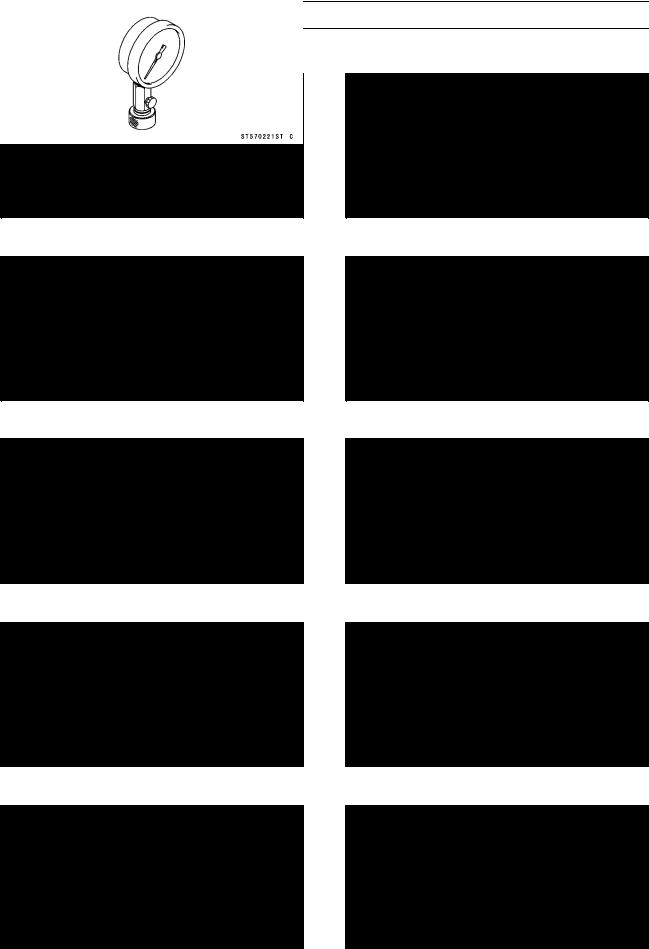
1-16 GENERAL INFORMATION
Special Tools and Sealants
Piston Ring Pliers: 57001-115
Inside Circlip Pliers: 57001-143
Oil Pressure Gauge, 5 kgf/cm²: 57001-125
Outside Circlip Pliers: 57001-144
Bearing Puller: 57001-135
Bearing Puller: 57001-158
Bearing Puller Adapter: 57001-136
Fork Cylinder Holder Handle: 57001-183
Steering Stem Bearing Driver: 57001-137
Compression Gauge, 20 kgf/cm²: 57001-221
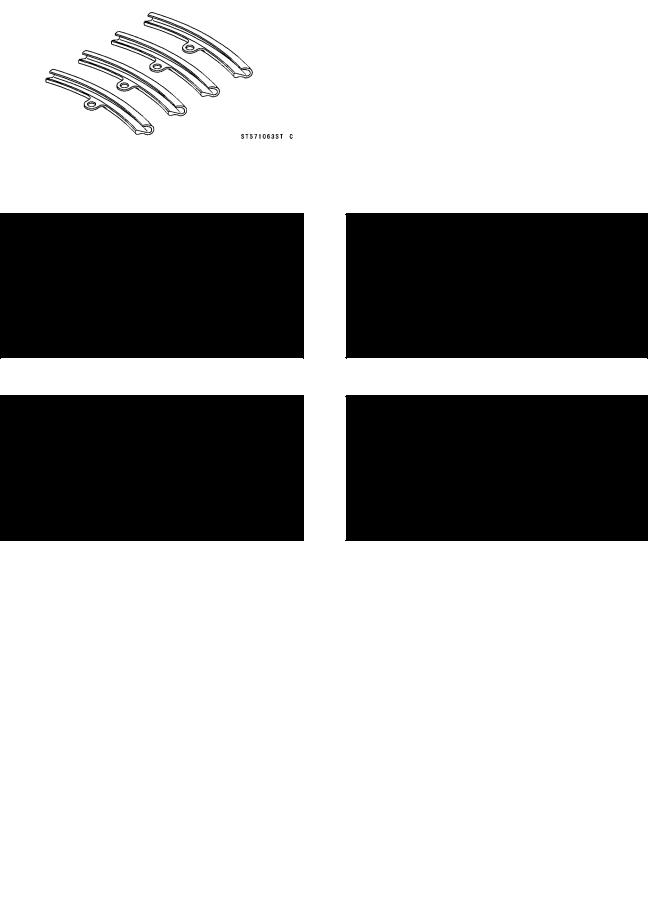
|
|
GENERAL INFORMATION 1-17 |
||
Special Tools and Sealants |
|
|
|
|
|
|
|
|
|
Valve Spring Compressor Assembly: |
|
Valve Guide Arbor, |
|
5.5: |
|
||||
57001-241 |
57001-1021 |
|
|
|
|
|
|
|
|
Bearing Puller Adapter: 57001-317
Spark Plug Wrench, Hex 18: 57001-1024
Bearing Driver,  32: 57001-382
32: 57001-382
Fork Cylinder Holder Adapter: 57001-1057
Piston Pin Puller Assembly: 57001-910
Oil Seal & Bearing Remover: 57001-1058
|
|
|
Fuel Level Gauge: |
|
Rim Protector: |
57001-1017 |
57001-1063 |
|
|
|
|
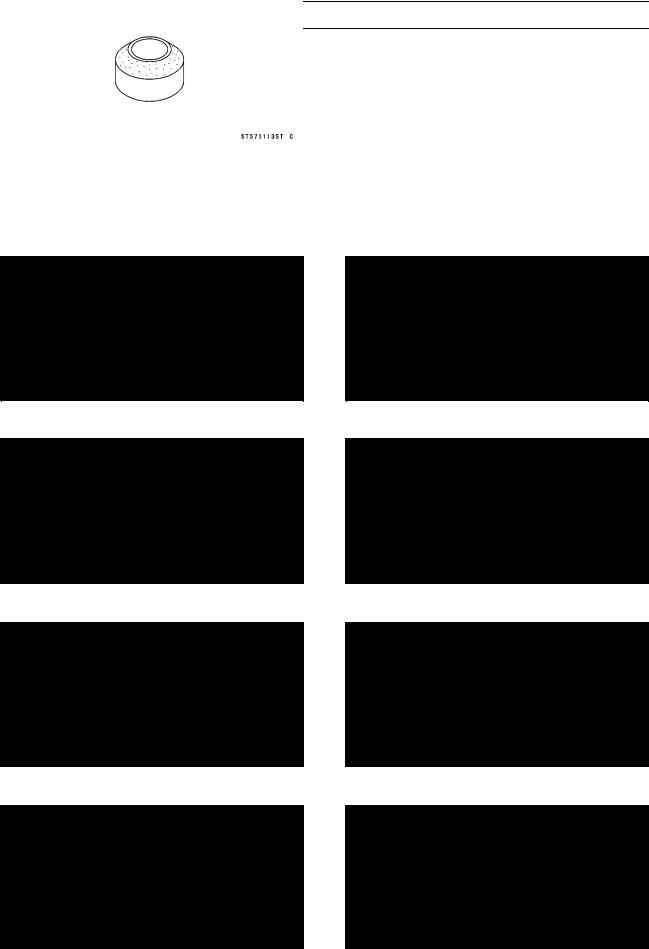
1-18 GENERAL INFORMATION
Special Tools and Sealants
Bead Breaker Assembly: |
|
Piston Ring Compressor Grip: |
57001-1072 |
57001-1095 |
|
|
|
|
Steering Stem Bearing Driver Adapter,  34.5: 57001-1074
34.5: 57001-1074
Piston Ring Compressor Belt,  67
67  79:
79:
57001-1097
Head Pipe Outer Race Press Shaft: 57001-1075
Steering Stem Nut Wrench: 57001-1100
Head Pipe Outer Race Driver,  51.5: 57001-1076
51.5: 57001-1076
Head Pipe Outer Race Driver,  46.5: 57001-1106
46.5: 57001-1106
Valve Guide Reamer,  5.5: 57001-1079
5.5: 57001-1079
Valve Seat Cutter, 45° -  24.5: 57001-1113
24.5: 57001-1113
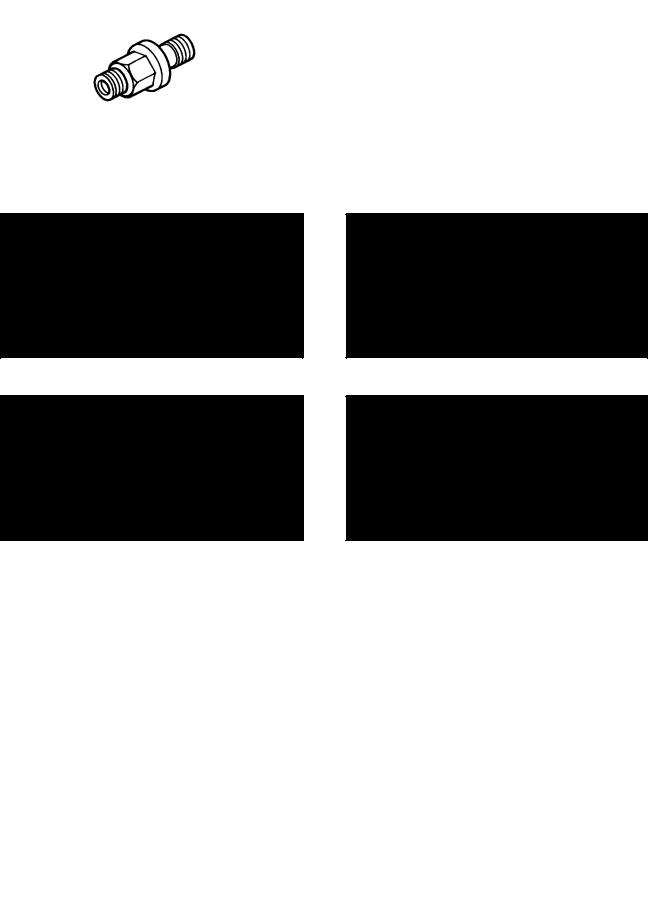
|
|
|
|
GENERAL INFORMATION 1-19 |
Special Tools and Sealants |
|
|
||
|
|
|
|
|
Valve Seat Cutter, 32° - |
|
25: |
|
Bearing Driver Set: |
|
||||
57001-1118 |
|
|
57001-1129 |
|
|
|
|
|
|
Valve Seat Cutter, 32° -  30: 57001-1120
30: 57001-1120
Compression Gauge Adapter, M12 × 1.25: 57001-1183
Valve Seat Cutter, 60° -  30: 57001-1123
30: 57001-1123
Valve Seat Cutter, 45° -  30: 57001-1187
30: 57001-1187
Valve Seat Cutter Holder,  5.5: 57001-1125
5.5: 57001-1125
Valve Spring Compressor Adapter,  22: 57001-1202
22: 57001-1202
|
|
|
Valve Seat Cutter Holder Bar: |
|
Oil Pressure Gauge Adapter, M14 × 1.5: |
57001-1128 |
57001-1209 |
|
|
|
|
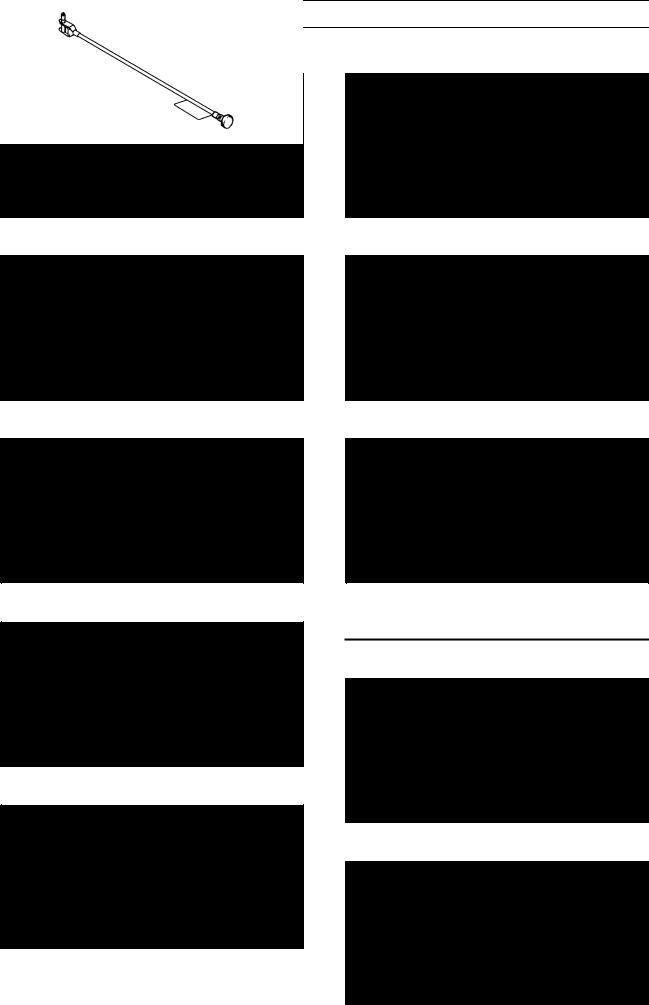
1-20 GENERAL INFORMATION
Special Tools and Sealants
Rotor Puller, M16/M18/M20/M22 × 1.5: 57001-1216
Fork Outer Tube Weight: 57001-1218
Front Fork Oil Seal Driver: 57001-1219
Jack: 57001-1238
Timing Light: 57001-1241
Clutch Holder: 57001-1243
Oil Filter Wrench: 57001-1249
Bearing Remover Head,  15 ×
15 ×  17: 57001-1267
17: 57001-1267
Carburetor Drain Plug Wrench, Hex 3: 57001-1269
Fork Oil Level Gauge: 57001-1290
Pilot Screw Adjuster, C: 57001-1292
